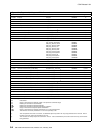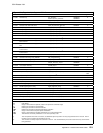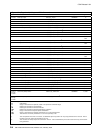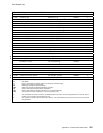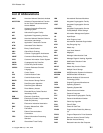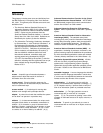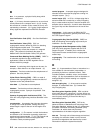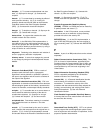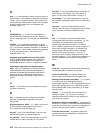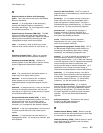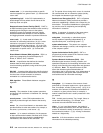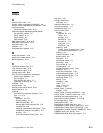CCA Release 2.54
B
bus. In a processor, a physical facility along which
data is transferred.
byte. (1) A binary character operated on as a unit and
usually shorter than a computer word. (A) (2) A string
that consists of a number of bits, treated as a unit, and
representing a character. (3) A group of eight adjacent
binary digits that represents one EBCDIC character.
C
Card-Verification Code (CVC). See Card-Verification
Value.
Card-Verification Value (CVV). CVV is a
cryptographic method, defined by VISA, for detecting
forged magnetic-striped cards. This method
cryptographically checks the contents of a magnetic
stripe. This process is functionally the same as
MasterCard’s Card-Verification Code (CVC) process.
Commercial Data Masking Facility (CDMF). CMDF is
an alternate algorithm for data confidentiality
applications, based on the DES algorithm with an
effective 40 bit key strength.
channel. A path along which signals can be sent; for
example, a data channel or an output channel. (A)
ciphertext. Text that results from the encipherment of
plaintext. See also plaintext.
Cipher Block Chaining (CBC). CBC is a mode of
operation that cryptographically connects one block of
ciphertext to the next plaintext block.
clear data. (1) Data that is not enciphered.
cleartext. Text that has not been altered by a
cryptographic process. Synonym for plaintext. See
also ciphertext.
Common Cryptographic Architecture (CCA). The
CCA API is the programming interface described in this
manual.
concatenation. An operation that joins two characters
or strings in the order specified, forming one string
whose length is equal to the sum of the lengths of its
parts.
configuration. (1) The manner in which the hardware
and software of an information processing system are
organized and interconnected. (T) (2) The physical and
logical arrangement of devices and programs that
constitutes a data processing system.
control program. A computer program designed to
schedule and to supervise the programs running in a
computer system. (A) (I)
control vector (CV). In CCA, a 16-byte string that is
exclusive-ORd with a master key or a Key-Encrypting
Key to create another key that is used to encipher and
decipher data or data keys. A control vector determines
the type of key and the restrictions on the use of that
key.
coprocessor. In this manual, the IBM 4758 PCI
Cryptographic Coprocessor, generally also when using
the CCA Support Program.
Cryptographic Key Data Set (CKDS). CKDS is a
data set containing the encrypting keys used by an
installation. See key storage.
Cryptographic Node Management utility (CNM).
One of the utility programs supplied with the CCA
Support Program. It enables you to initialize the
Coprocessor access controls and the cryptographic
master keys.
cryptography. The transformation of data to conceal
its meaning.
D
data. (1) A representation of facts or instructions in a
form suitable for communication, interpretation, or
processing by human or automatic means. Data
includes constants, variables, arrays, and character
strings. (2) Any representations such as characters or
analog quantities to which meaning is or might be
assigned. (A)
data-encrypting key. (1) A key used to encipher,
decipher, or authenticate data. (2) Contrast with
Key-Encrypting Key.
Data Encryption Algorithm (DEA). DEA is a 64-bit
block cipher that uses a 64-bit key, of which 56 bits are
used to control the cryptographic process and 8 bits are
used for parity checking to ensure that the key is
transmitted properly.
Data Encryption Standard (DES). DES is the
National Institute of Standards and Technology Data
Encryption Standard, adopted by the U.S. government
as Federal Information Processing Standard (FIPS)
Publication 46. which allows only hardware
implementations of the data-encryption algorithm.
data set. The major unit of data storage and retrieval,
consisting of a collection of data in one of several
prescribed arrangements and described by control
information to which the system has access.
X-4 IBM 4758 CCA Basic Services, Release 2.54, February 2005



